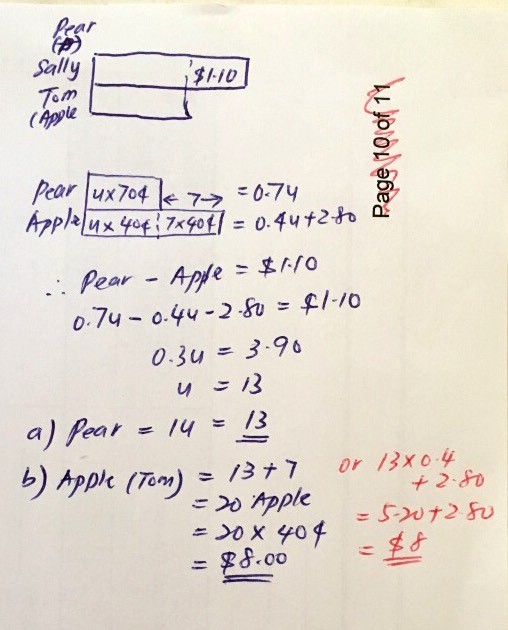Ask Singapore Homework?
Upload a photo of a Singapore homework and someone will email you the solution for free.

Question
primary 6 | Maths
| Measurement
One Answer Below
Anyone can contribute an answer, even non-tutors.

Can anyone help on this question . Tks
Wait for my next post.
Apple 40c
Sally bought pears ONLY
Tom bought apples ONLY
Sally spent $1.10 more than Tom, but has 7 fruits fewer than Tom.
The idea is to make the number of fruits bought “the same”.
Let’s pretend Sally bought 7 more fruits i.e. 7 more pears.
The extra pears would have cost Sally a further $4.90. This makes Sally spend $6 more than Tom for an equal number of fruits.
Each pear is 30c more expensive than each apple. But a certain number of pears is $6 i.e. 600c more than the same number of apples.
This number is
600/30 = 20
So Sally would have bought 20 pears in this instance, but this assumes Sally had bought 7 more pears.
Sally bought 13 pears.
As for Tom, he bought 20 apples, with a total monetary value of $8 since each Apple costs 40c.
If Tom buys 7 less apples than now, he would have spent $2.80 less than before.
As a result, he would have spent $3.90 less than Sally.
The price difference between one pear and one Apple is 30c, while the price difference between a number of pears and the same number of apples is $3.90 i.e. 390 cents, so this number is
390/30 = 13
So Tom would have bought 13 apples because of the 7 Apple reduction.
Sally bought 13 pears.
Tom actually bought 20 apples, with a numerical cost of $8 as before.
Let the number of fruits Sally bought be x. All these comprise pears only.
Since Tom buys 7 more fruits than Sally, Tom buys (x + 7) fruits. All these comprise apples only.
(Note that x is a mystery number to be found, so we can only write x + 7 to denote a number which is 7 more than x)
Since the cost of 1 pear is 70c, the cost of x pears is the product of these two numbers,
70x cents.
Since the cost of 1 Apple is 40c, the cost of (x + 7) apples is the product of these two numbers,
40 times (x + 7)
= 40 times x + 40 times 7
= (40x + 280) cents.
Since Sally paid $1.10 more than Tom,
Sally’s spending - Tom’s spending = 110 cents,
70x - (40x + 280) = 110
70x - 40x - 280 = 110
(be careful of the plus and minus signs as you expand out the brackets)
30x - 280 = 110
(like terms combine together)
Adding 280 to both sides,
30x - 280 + 280 = 110 + 280
30x = 390
(again, like terms combine together)
Dividing both sides by 30,
30x / 30 = 390 / 30
x = 13
So sally bought 13 pears.
Tom bought (x + 7) = 13 + 7 (since x = 13) = 20 apples.
Cost of Tom’s apples is 20 x 0.40 = 800 cents = $8.
See 1 Answer

This is a good start for a transition from model diagrams to algebra as you proceed to secondary school.




